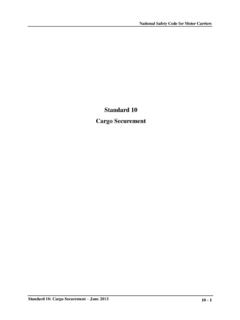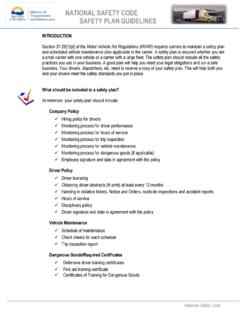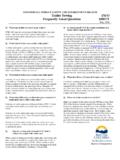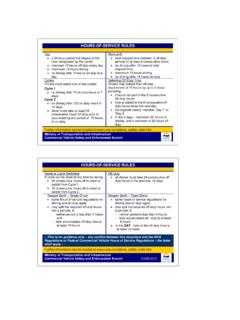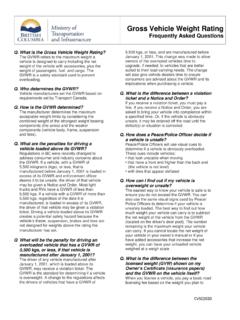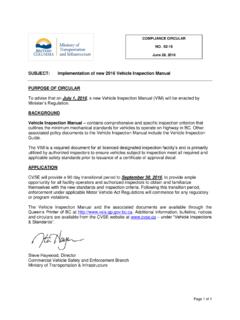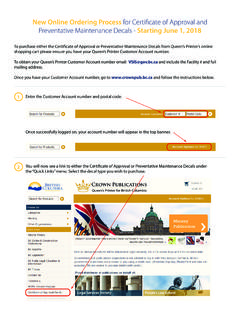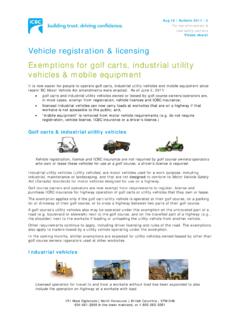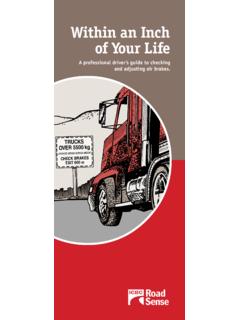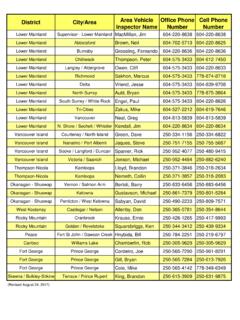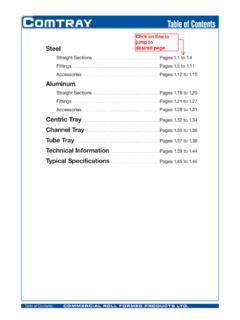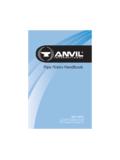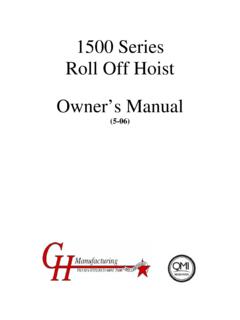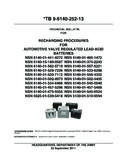Transcription of Statement of Limitation Contents Cargo Security - …
1 Cargo Statement of Limitation Contents This booklet is intended as a guide only and as Introduction .. 1. such has been written as a plain language General Cargo Securement Requirements .. 1. Security summary to help you understand some of the laws in British Columbia that affect Cargo Security . This guide covers laws in force as of March 2005. You Inspecting Cargo .. 3. General Requirements for 3. Number of Tiedowns .. 4. should refer to the Motor Vehicle Act (MVA), the Strength of Tiedowns .. 6. Motor Vehicle Act Regulations (MVAR) and National Safety Code Standard 10, Cargo Determining Working Load Limit .. 7. Grades of Chain .. 7. Securement (the standard) for a full Statement of Chain Connector Links .. 8. the law. In the event of a conflict between this Wire Rope .. 9. booklet and any provision of the MVA, MVAR or Webbing .. 10. the standard, the MVA, MVAR and the standard shall apply. The MVA, MVAR and the standard are Bagged 11.
2 Subject to change without notice. Aggregate 11. Front End Structures .. 13. 13. Height .. 14. Width .. 14. Penetration Resistance .. 14. 14. Hanging 15. Grinding 13. Logs .. 15. Vehicles Transporting Logs or Poles .. 15. Log Configuration .. 16. Short Logs .. 16. Long 16. Inspecting Log Loads .. 17. Building Products .. 17. Metal Coils .. 19. Paper Rolls .. 20. Concrete Pipe .. 20. Intermodal 21. Vehicles as Cargo .. 21. Roll-on/roll-off and Hook Lift Containers .. 22. Boulders .. 23. Baggage and Cargo on Buses .. 23. March 2005. Introduction General Cargo Securement The Motor Vehicle Act Regulations (MVAR) make it an Requirements offence to operate a vehicle unless its Cargo is All Cargo on or within a vehicle must be secured so that adequately secured. The MVAR specify requirements for it cannot leak, spill, blow off, fall from, fall through or vehicles transporting logs or poles, covers for loose otherwise be dislodged from a vehicle.
3 Cargo must also loads, affixing and marking front end structures and be secured so that it cannot shift enough to affect the carrying luggage in buses. The MVAR also adopt the maneuverability or stability of a vehicle. Cargo means Cargo securement requirements outlined in National all articles or materials carried by a vehicle, including Safety Code Standard 10 (the standard) as BC law. The those used in the operation of the vehicle. standard outlines general securement requirements that apply to all types of Cargo and requirements for certain The chosen Cargo securement system must be commodities. Unless otherwise specified, the general appropriate for the Cargo 's size, shape, strength and Cargo securement requirements apply in addition to the characteristics. The securement system may include the commodity specific requirements. following components: Following these Cargo Security requirements should x vehicle structure ensure that Cargo remains on a vehicle, without shifting, x blocking and bracing equipment, and / or when a driver brakes suddenly or changes direction x securing devices, such as tiedowns.
4 Quickly to avoid an incident. The securement system must be able to withstand the The information in this pamphlet is based on the following forces: requirements outlined in Division 35 of the MVAR and the standard. Carriers and drivers should refer to the x forward force of 80% of Cargo weight standard for further information on both the general and x rearward force of 50% of Cargo weight Cargo specific requirements. Copies of both the standard and the MVAR can be obtained through the x sideways force of 50% of Cargo weight, and Commercial Vehicle Safety and Enforcement Branch x upwards force of 20% of Cargo weight. website at The load on each component of the securement system Application must not exceed the working load limit of the component. Components of a Cargo securement system The MVAR and standard apply to all vehicles carrying must not be damaged, cracked, cut or weakened. Cargo on highways, regardless of the vehicle's gross Components must be in proper working order and fit for vehicle weight.
5 The requirements do not apply to: the purpose for which they are used. x vehicles on roads that are not highways, or x vehicles crossing highways on highway crossing permits. 1 2. Inspecting Cargo Edge protectors must be used where a tiedown could be Machinery or fabricated structural items that require cut or subject to abrasion where it contacts Cargo . special methods of securement because of their size, Under section 3 of the standard, drivers must inspect Wherever practical, tiedowns should be located inboard design, shape or weight are exempted from these vehicles before driving to: of rub rails. minimum tiedown requirements. x confirm that equipment used in the vehicle's operation One long chain could be used as two tiedowns, provided Article Description Minimum Number is secured that each tiedown has an independent tensioning device of Tiedowns Required so that the failure of one tiedown application does not m (5 ft) or shorter and x ensure that Cargo does not interfere with the safe 1.
6 Result in failure of both. 500 kg (1,100 lb) or lighter operation of the vehicle Tiedowns exhibiting any of the following must not be m (5 ft) or shorter and x ensure that Cargo does not interfere with exiting the over 500 kg (1,100 lb). 2. used for Cargo securement: vehicle, and More than m (5 ft) but x chain containing cracked welds or links 2. x make any necessary adjustments to the Cargo and m or less Cargo securement system. x chain containing bent, twisted, stretched or collapsed 2 + 1 tiedown for every links Longer than m (10 ft) additional m (10 ft). A driver must re-inspect the Cargo securement system or part thereof within 80 km from the point where the Cargo was loaded x chain links weakened by gouges, nicks or pits and on a regular basis during the trip at the earliest of: EXAMPLE 1. x chain incorrectly repaired x a change in duty status of the driver A m long article weighing 600 kg on a flat deck. x chain links obviously worn or showing other visible x 3 hours of driving, or evidence of loss of strength x 240 km of driving x knots in any portion of chain, wire rope or webbing since the last inspection.
7 X spread or disturbed grabhooks Drivers must find safe locations to pull off the highway x cuts, nicks or splits in nylon webbing and inspect Cargo . Drivers must record Cargo x wire cable with missing strands or wraps, or securement inspections on their daily logs. As the article is not prevented from forward movement x an anchor point which is weakened or shows loss of and it weighs more than 500 kg, two tiedowns are A driver need not inspect Cargo if the Cargo is sealed strength due to cracks, breaks or distortion. required. If practical, the tiedowns should be equally and the driver has been ordered not to inspect it, or if the spaced along the article. Cargo is inaccessible. Number of Tiedowns EXAMPLE 2. General Requirements for Tiedowns The table on the following page illustrates the minimum Two articles arranged on a flat deck. The first article is number of tiedowns required if an article of Cargo on or butted against the vehicle's bulkhead.
8 Except for steel strapping, tiedowns must be designed, within a vehicle is not prevented from forward movement constructed and maintained so that a driver can tighten by a front end structure, a tiedown, other Cargo or them. Tiedowns must be taut and must not slip, loosen, another device, such as a drop on a step deck trailer. unfasten, open or release while a vehicle is in operation. When Cargo is prevented from forward movement the minimum number of tiedowns required is one tiedown for every m (10 ft) of length or part thereof. 3 4 5. As it is prevented from forward movement by the Determining Working Load Limit CHAIN CONNECTOR LINKS. bulkhead, the first article requires only two tiedowns. Since the second article is butted against the article in The working load limit of a tiedown is the lowest working front, it requires only one tiedown. load limit among the tiedown components, anchor points and associated connector or attachment mechanisms.
9 Strength of Tiedowns The working load limit of a component is determined by If tiedowns are used to secure Cargo , the aggregate referring to either the numeric working load limit or grade Pear shaped missing links and double clevis links are working load limit of the tiedowns must be at least 50% marked on the component by the manufacturer. Where compatible with Grade 30 short link (BBB) chains and of the weight of the Cargo . The aggregate working load the manufacturer does not mark a tiedown, the standard lower grades. limit is calculated by totaling of the working load limit includes tables of working load limits for various tiedown for each end section of a tiedown that is attached to an materials including chain, synthetic webbing, wire rope, anchor point. manila rope, synthetic rope and steel strapping. Alloy connecting links are Requirements for some of these materials are compatible with Grade 70. EXAMPLE 3. reproduced in the sections below.
10 Chains. A m long article weighing 600 kg on a flat deck The standard prohibits the use of unmarked tiedowns after January 1, 2010. Quick connectors are not GRADES OF CHAIN suitable for any heavy duty operation. The standard includes the following table of working load limits for various grades of chain. Size Grade 3 Grade 43 Grade 70 Grade 80 Grade 100 Chain hooks are generally The aggregate working load limit of the tiedowns must Proof coil High test Transport Alloy Alloy compatible with chain of the be no less than 300 kg (50% of 600 kg). In accordance 7 mm 590 kg 1180 kg 1430 kg 1570 kg 1950 kg (1/4 in) (1300 lb) (2600 lb) (3150 lb) (3500 lb) (4300 lb). same size and grade ( , 7. with the table on the previous page, a m long article 8 mm 860 kg 1770 kg 2130 kg 2000 kg 2600 kg mm alloy grab hooks are that is not prevented from forward movement requires (5/16 in) (1900 lb) (3900 lb) (4700 lb) (5100 lb) (5700 lb) compatible with 7 mm alloy three tiedowns.)
